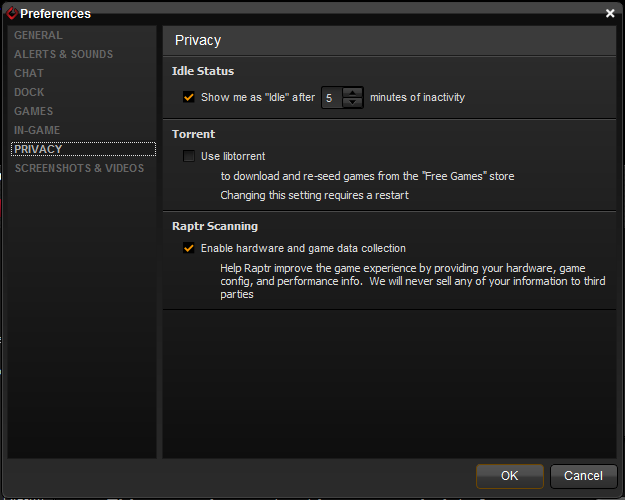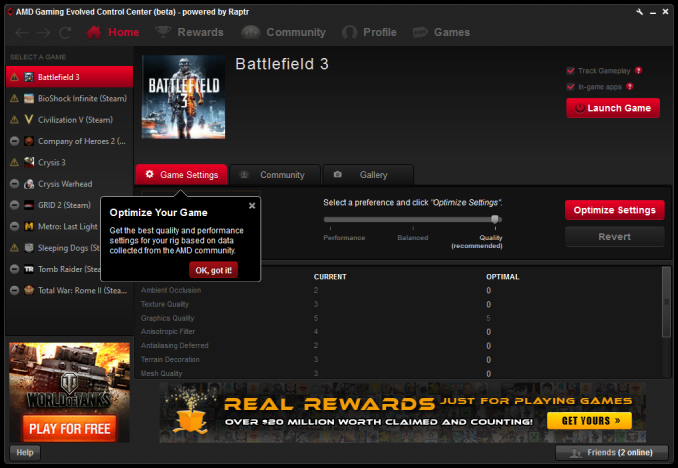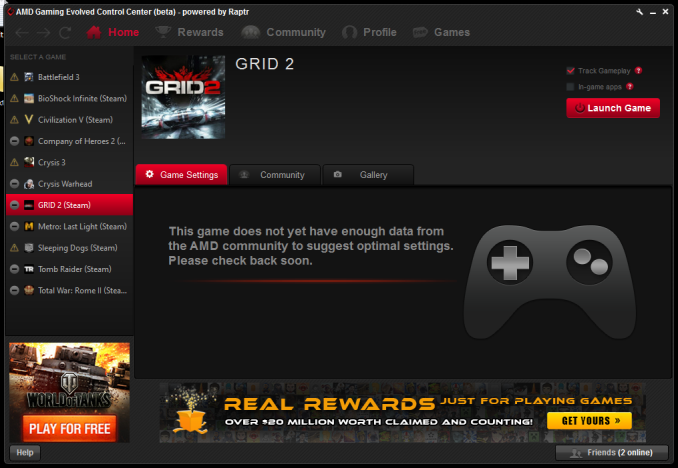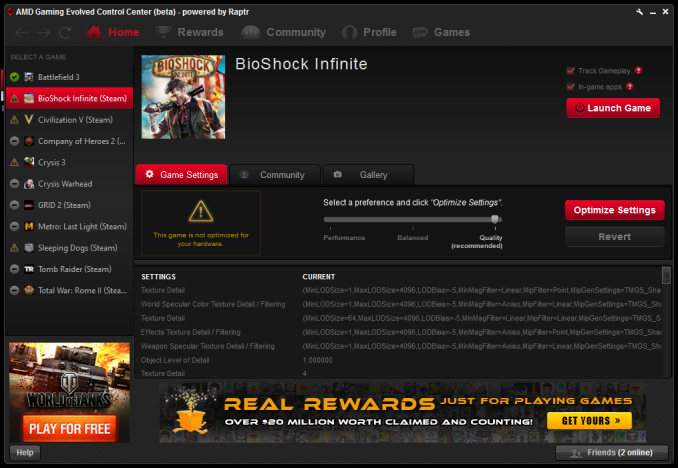The AMD Radeon R9 290 Review
by Ryan Smith on November 5, 2013 12:01 AM EST- Posted in
- GPUs
- AMD
- Radeon
- Hawaii
- Radeon 200
AMD's Gaming Evolved Application
During AMD’s “partner time” block at the 2014 GPU Product Showcase, one of the projects presented was the Raptr social networking and instant messaging application. Put together by the company of the same name, AMD would be partnering with Raptr to produce an AMD branded version of the utility called the “AMD Gaming Evolved App, Powered By Raptr”.
In a nutshell, the Gaming Evolved App (GEA) is AMD’s attempt to bring another value add feature to the Radeon brand. And although AMD will never explicitly say this, to be more specific the GEA is clearly intended to counter NVIDIA successful GeForce Experience utility, which exited beta back in May and has been continuing to add features since.
Raptr/GEA contains a wealth of functionality, with the application being several years old at this point, but the key feature as a video card utility and the reason AMD has picked it up is its latest feature addition, the game optimization service. Just launched last month in beta, the optimization service is a functional clone of GeForce Experience’s optimization service. Designed with the same goals in mind, the GEA optimization service is intended to offer the ability for gamers disinterested in configuring their games – or even just looking for a place to start – a way to simply download a suitable collection of settings for their games and hardware and apply those settings to their games.
The concept is in practice very similar to the recommended settings that most games apply today, but driven by the GPU manufacturer instead of the game developer, and kept up to date with hardware/software changes as opposed to being set in stone when the game went gold. Even for someone like a professional GPU reviewer, it’s a very nifty thing to have when turning up every setting isn’t going to be practical.
To get right to the point then, while we’re big fans of the concept it’s clear that this is a case of AMD tripping over themselves in trying to react to something NVIDIA has done, by trying to find the fastest way of achieving the same thing. Like GeForce Experience, AMD has started bundling GEA with their drivers and installing it by default, but unlike GFE it’s still in beta at this point, and a very rough beta at that. And not to take an unnecessary shot at AMD, but even in beta GeForce Experience wasn’t this raw or this incomplete.
So why are we so down on GEA? There are a few reasons, but the most basic of which is that the Raptr service lacks enough performance data for GEA to offer meaningful recommendations. Even on a fairly old card like a Radeon HD 7950, GEA was only able to find settings for 5 of the 11 games we have installed on our GPU testbed, failing to include settings for a number of games that are months (if not years) old. To be fair every service has to start out somewhere, and GFE certainly didn’t launch with a massive library of games, but 5 games, none newer than March, is a particularly bad showing.
Now a lot of this has to do with how Raptr collects the performance data it uses for recommendations. NVIDIA for their part decided to do everything in house, relying on their driver validation GPU farms to benchmark games across multiple settings to find a good balance based on parameters picked by the GFE development team. Raptr, though backed by AMD, does not have anything resembling NVIDIA’s GPU farms and as such is going the crowdsourced route, relying on telemetry taken from Raptr users’ computers. Raptr’s data acquisition method is not necessarily wrong, but it means there’s no one to bootstrap the service with data, which means the service has started out with essentially nothing.

Raptr for their part is aware of the problem they’re faced with, and in time the distribution of the GEA along with their own Raptr application will hopefully ensure that there are enough users playing enough games out there to collect the necessary data. Even so, they did have to implement what amounts to a solution to the tragedy of the commons problem to make sure that data gets collected; users cannot receive settings from the Raptr service unless they provide data in return. Turning off the telemetry service will also turn off the client’s ability to pull down settings, full stop. Given the service’s requirements for data collection it’s likely the best solution to the problem, but regardless we have to point out that Ratpr is alone in this requirement. NVIDIA can offer GFE without requiring performance telemetry from users.
Moving on then, the other showstopper with GEA’s current optimization service is that it’s obvious the UI has been an afterthought. The GEA UI lists settings by the values used in a game’s settings file, rather than the name of that value. E.g. “Ultra” texture quality in Bioshock Infinite is labeled as texture detail “4”, or worse. Without sufficient labeling it’s impossible to tell just what those settings mean, let alone what they may do. As such applying GEA settings right now is something of a shot in the dark, as you don’t know what you’re going to get.
Finally, presumably as a holdover from the fact that Raptr is free, GEA runs what can only be described as ads. These aren’t straight up advertisements, rather directing users towards other services Raptr/GEA provides, such as Free-2-Play games and a rewards service. But the end game is the same as these services are paid for by Raptr’s sponsors and are intended to drive users towards purchasing games and merchandise from those sponsors. Which far be it for us to look down upon advertisements – after all, AnandTech is ad supported – but there’s something to be said for ad supported applications in a driver download. We're at something of a loss for explaining why AMD doesn't just foot the complete bill on their customized version of the Raptr client and have the ads removed entirely.
At any rate we do have some faith that in time these issues can be dealt with and the GEA can essentially be fixed, but right now the GEA is far too raw for distribution. It needs to go back into development for another few months or so (and the service bootstrapped with many more computer configurations and games) before it’s going to be of suitable quality for inclusion in AMD’s drivers. Otherwise AMD is doing their users a disservice by distributing inferior, ad supported software alongside the software required to use their products.
The Test
For the launch of the Radeon R9 290, the press drivers and the launch drivers will be AMD’s recently released Catalyst 13.11 Beta v8 drivers. Along with containing support for the 290 and the 47% fan speed override, the only other changes in these drivers involve Batman: Arkham Origins and Battlefield 4, games which we aren’t using for this review. So the results will be consistent with past drivers. Meanwhile for NVIDIA’s cards we’re continuing to use their release 331.58 drivers.
| CPU: | Intel Core i7-4960X @ 4.2GHz |
| Motherboard: | ASRock Fatal1ty X79 Professional |
| Power Supply: | Corsair AX1200i |
| Hard Disk: | Samsung SSD 840 EVO (750GB) |
| Memory: | G.Skill RipjawZ DDR3-1866 4 x 8GB (9-10-9-26) |
| Case: | NZXT Phantom 630 Windowed Edition |
| Monitor: | Asus PQ321 |
| Video Cards: |
AMD Radeon R9 290X AMD Radeon R9 290 XFX Radeon R9 280X Double Dissipation AMD Radeon HD 7970 GHz Edition AMD Radeon HD 7970 AMD Radeon HD 6970 AMD Radeon HD 5870 NVIDIA GeForce GTX Titan NVIDIA GeForce GTX 780 NVIDIA GeForce GTX 770 |
| Video Drivers: |
NVIDIA Release 331.58 AMD Catalyst 13.11 Beta v1 AMD Catalyst 13.11 Beta v5 AMD Catalyst 13.11 Beta v8 |
| OS: | Windows 8.1 Pro |













295 Comments
View All Comments
doggghouse - Wednesday, November 6, 2013 - link
So at 60dB, it's as loud as someone talking next to you. In other words, you would have some difficulty hearing another person over the sound of the GPU fan. I would say that's pretty loud.I think the 290 and 290X have a lot of potential, but with the stock cooling I would stay away from it.
Vorl - Wednesday, November 6, 2013 - link
I don't remember the exact noise test, but I thought the measurement was taken right next to the card, at the fan... so if you put distance, and a case around the card, it will not be nearly as loud as that.ThomasS31 - Wednesday, November 6, 2013 - link
R9 290 series is the worst ever launch for AMD... this was a chance to show how professional they are and gain market share with a great opportunity and product... and they screwed it up and failed.And this is not he first time they failed to monetize their products. So maybe there shall be some personal consequences and changes needed.
Hope the new hires (leaders) change this and this is the last time we saw great products hindered with bad execution.
After the 7990 cooler I and what nVidia did they learned the lessons... but not.
And now as I hear they are not allowing custom coolers and/ or limit manufacturers in the use of the best coolers/design they could do... as competition is bad for market or what???
Mondozai - Friday, December 13, 2013 - link
lolmartixy - Wednesday, November 6, 2013 - link
So the takeaway is:There's a new king in town, and it's name is AMD.
For now...
+You get to be Mantle-proof.
What I wanna see now is Mantle on an nV card and g-sync on an AMD card.
nevertell - Wednesday, November 6, 2013 - link
Why is it so that when a ridiculously loud nvidia card gets released, people go crazy about the heat and noise generated, but when AMD does the same, they only focus on the performance?I do understand that the price and performance for these cards is pretty ground braking, but then again, AMD used to release some nasty adverts about people using Fermi cards. And fermi cards were not even this loud.
And considering the fact that the testbed here was probably properly ventilated and designed for hot and fast cards, I believe there is a significant portion of the market, who will buy the card and stick it into a small or badly ventilated or just crammed case and call it a day. And those people will not be able to get the performance advertised here, as their cards will probably throttle a lot more.
But I do love how the roles are switching, only 3 generations ago, AMD's and Nvidia's positions were exactly the opposite, at least in the power and noise, and mostly power efficiency, departments.
We still have to wait for 780ti, but seeing as titan is already having a run for it's money.
Death666Angel - Wednesday, November 6, 2013 - link
I don't care one bit about the loudness of a card. Anything I own has to be watercooled and the custom water cooling block costs the same whether it is from nVidia or AMD. So this card is a win on all fronts. And unless you have to buy reference design without switching to WC, I don't think you'll be disappointed.It's really hard to read 5 paragraphs on noise when that is the least of anyones concerns when buying a video card. People who are concerned with it have custom cooling stuff which is the same for most cards (nVidia or AMD), since most cards are the same. Or they don't care since their other stuff is louder and/or they use good headphones. So I think knocking the 290 for loudness is a bit petty. :)
Achaios - Wednesday, November 6, 2013 - link
Can't wait for Gigabyte's R9 290 SOC (Super Overclock) with 3X Windforce Cooler. I drool at the thought.ecuador - Wednesday, November 6, 2013 - link
Ryan, it is interesting to contrast this review to Anand's review of the FX 5800. You sound much more damning for a card that is much cheaper and faster than the competition at a 9.7dB louder, than Anand was for a card that was slower and 13dB louder than the competition back then! Ok, it is not for everyone until it gets custom coolers, but it sure gives you a lot for that tradeoff. The mystery is why AMD does not make a cooler that is worth a damn!swing848 - Wednesday, November 6, 2013 - link
Anand,Most people that read your reviews know you are a GeForce fan boy. And, the last page of your "review" tells people not to purchase the R9 290.
In fact, many people purchase this card BECAUSE THEY WANT IT. Let the buyer decide what he or she want in price and performance, and stop poking AMD in they eye with your GeForce stick. If anything give advice to people on how to keep temperatures under control with the least noise possible; but, no, you have to get on your GeForce box and pound AMD ... again. How much do they pay your or your company?
The R9 290 is a great card, and after reading several reviews, know it.